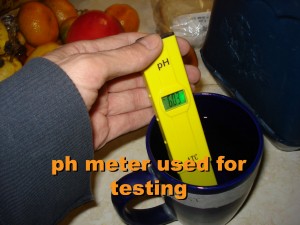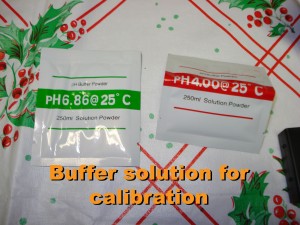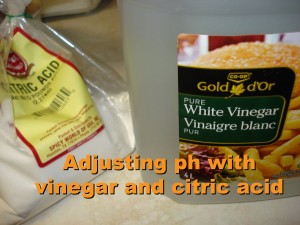We use well water here, which is a little on the hard side. Tomatoes tolerate it, but most other plants start to struggle once past the seedling stage – I would guess it’s because any buffering capacity in the soil has been overcome and the soil is starting to resemble the pH of the water that’s been used.
In the past, I’ve used a few tablespoons of vinegar when watering blueberries that had started to brown, and more recently when I’ve been too lazy to distill water (it takes so long!), I have used 1-2 tablespoons of vinegar in a 4L watering can for spruce (a random guess that has kept them alive thus far).
Fast forward to today, and I figured it was about time to start getting correct pH levels!
—
Before I get to the numbers (what amounts of citric or vinegar resulted in what pH levels), I’ll mention how I arrived at them.
I grabbed a digital pH meter from Amazon. This is the common cheap yellow one sold under such highly renowned brands as “Dr. Meter”, “Etekcity”, “Dr. Health”, and “Xcellent Global”. They all look pretty much identical, all have mixed reviews, and the biggest difference seems to be how many packets of calibration/buffering powder they come with (if any). This is what it looks like:
Calibration and why accuracy went out the window quickly
There’s a 6.86 and 4.01 pH packet that you’re supposed to use to calibrate. Add the 6.86 to 250mL (a cup) of water, mix it up, stick the meter in a little and adjust the screw. Then do the same with the 4.01 pH packet with a new cup of water.
I did this with distilled water and had the same issue that others have run into: You could calibrate it at 6.86, but then it was a little off at 4.01 (showed 4.10). Calibrate at 4.01 and it’s off at 6.86 (showed 6.65).
Since plants usually tolerate wide pH ranges like 5.5-7.0, this wasn’t a huge deal for me. As long as I’m not at the min/max, it’s not the end of the world if I’m off by 0.1 or 0.2.
The Numbers!
- pH of the tap water: 7.5 – 7.7 pH
- pH of water run through the distiller: 6.1 – 6.3 pH
The distilled water’s just listed for reference. It’s expected to be a little acidic since it absorbs CO2 and forms carbonic acid, getting close to 6 was lower than I had expected. I measured a few times (and a few samples) to be sure.
3.5 – 4L of Tap Water (7.5 – 7.7 pH) with Citric Acid added:
- 1/8 tsp citric acid: 6.1 – 6.3 pH
- 1/4 tsp citric acid: 5.3 – 5.5 pH
- 1/2 tsp citric acid: 4.4 – 4.6 pH
- 1 tsp citric acid: ~3.5 pH
- 1 tbsp citric acid: ~2.5 pH
Note that the watering can was filled with tap water to roughly 3.75 L and thoroughly rinsed after each attempt. Measuring out powder is easy too, so I’m fairly happy with these numbers.
Because such small amounts of citric acid have such a large effect, I wouldn’t recommend using citric acid to adjust your pH if operating in “guess mode”. You really need to measure stuff here (and know your original pH) since it doesn’t take much to get into plant-killing territory.
Even with a pH meter, an accidental double-dose or poor measurement could have a drastic effect, so keep that in mind.
3.5 – 4L of Tap Water (7.5 – 7.7 pH) with Vinegar (5% acetic acid) added:
- 1 tbsp vinegar: 5.8 – 6.0 pH
- 2 tbsp vinegar: 5.4 – 5.6 pH
- 3 tbsp vinegar: 5.0 – 5.2 pH
- 4 tbsp vinegar: 4.5 – 4.7 pH
- 5 tbsp vinegar: 4.4 – 4.6 pH
- 6 tbsp vinegar: 4.2 – 4.4 pH
- 7 tbsp vinegar: 4.1 – 4.3 pH
- 8 tbsp vinegar: 4.0 – 4.2 pH
- 9 tbsp vinegar: 4.0 – 4.2 pH (actually 0.07 less)
I was pretty sloppy measuring here since it’s a little cumbersome to pour from the jug of vinegar into a little tablespoon. The difference between 8 and 9 tbsp was really small (0.07), which is why I stopped there. Getting below a pH of 4 wasn’t going to happen without a *lot* of vinegar, and we’re much too acidic for most plants at that point anyway.
The really interesting thing to note here is that things REALLY started to slow down once I hit a pH of about 4.5. I’ve read about spruce being fine at 4.5 and tolerating as low as 4.0. That gives a lot more leeway than I had expected – spruce might be a little tough to over-acidify with vinegar (within reason).
If nothing else, “ballparking” pH with vinegar should be a lot safer than trying to ballpark with a stronger acid, particularly when dealing with more acid-loving plants (spruce/blueberries/etc). I had previously been using 2 tbsp – turns out, they probably would have survived anything up to 9.
—
Anyway, I’ll leave it at that. This is mainly for my own use, but if you’re reading around and trying to “guestimate” how much you’ll need to acidify your water, hopefully you find something above to be helpful.
However, keep in mind that my tap water is undoubtedly much different from yours. Different starting pH, different dissolved minerals, etc. What brings my water to a plant-happy-place might turn your water into a plant-death-solution, so try to get a hold of some pH testing materials. If that’s out of the question, at least search around to see what results others have come up with ;)



I've also been using vitamin c to remove chlorine from the water.
Hope this is helpful.
If it's a large raised bed that requires a lot of watering, it could be worth looking into sulfur bags (often found as "garden sulfur"), since they break down over time and acidify the soil. Getting the concentration right can be tricky, but if you start with smaller amounts and test the soil PH every couple months you should be able to get to a point where you know roughly how much to add annually to keep the soil at the desired PH.
Thank you for this article. I’m trying to grow blueberries with the soil and water ph levels neutral. 4tbsp of vinegar in 4l of water will work I think. How often should you use (Daily or weekly) and how much per plant - 4litres? I don’t want to overdo it. Thanks. Suja.
Thank you,
Calling from Europe ☺
I just measured the capacity of all our measuring spoon sets (these are typical sets used for cooking). Surprisingly they all varied. They're older sets, but I really get the impression the manufacturers didn't care much for accuracy. Then again, looking at the differences between Wikipedia and the Google converter... I have to wonder if there's any consensus on what the capacity should be to begin with...
In any case, 5ml teaspoon and 14ml tablespoon is what I came up with in measuring the capacity of the spoons I used.
Assuming your New Zealand tablespoon is actually 15ml I suspect you should be alright. Obviously a pH meter or some test strips are ideal though.
That said, if your soil is alkaline, I suspect you'd want to continue using the pH-adjusted-with-vinegar-water until other longer-term soil acidifying amendments (garden sulfer etc) have taken effect. On the other hand, if the soil is sufficiently acidic but your water is extremely hard, you may need to adjust the pH of the vinegar continually until you get access to rainwater or distilled water.
I lower water ph using citric acid to 6 but after couple of hours the ph raise to 7 again. Whats the reason for this?
I’ve managed to adjust the pH of the water to 5.5 but it jumps back to 7.2 the day after. Is there any reason for this?
Initial ph of soil was 7.6. Organic matter 4.1
After watering soil with 5 different fluids that had corn growing in it for 5 weeks, the soil pH all went up
Soil watered with
DI Water. Resulted pH 8.2.
Vinegar mixture. 8.9
Tap water 8.3
Apple juice 8.5
Milk 8.4
What is the chemical reaction that would cause the pH to go up? Especially with the Vinegar solution ( pH of 2.6)
Just a quick question
If all were equal and your water was a pH of 8 would the same amounts of vinegar drop the ph the same amounts.
i.e 1 tbsp would drop the ph to 6.1-6.3.
Is that correct or do the equations change a lot depending on the starting pH?
To some degree you can see that behavior reflected in my results. The first smaller "hit" of acid in both cases dropped pH substantially compared to further tests with larger amounts. If my water had started at a pH of 10 I wouldn't be surprised if the first tablespoon of vinegar brought the pH down to under 7.
Pete
Do you need to use this for watering all the time instead of tap water or just every few months? I have skimmias in pots and the ground that get a bit yellow? Have been nurturing with erricaceus compost and acid plant feed but religiously watering with hard tap water.
Thanks
My pH meter is accurate to .1 for the digital readout of pH. I used vinegar at 5%.
1. I measured 4.12 pH for 3.5L with 4.33 tbsp. You measured 4.1 pH with your tbsp of 7. 7/4.33 = 1.6
2. I measured 4.2 pH for 4L with 1.667 tbsp. You measured 4.2 pH with your tbsp of 8. 8/1.667 = 4.8. If I average these two ratios I get 3.2 which is close to the ratio of tsp to tbsp.The initial equation is pH = C1 * tsp^C2 where the values for C1 and C2 are given below for water amounts of 3.5L, 4L and 5L.
The power fit to the data is very close between the equations and the data.
*** Are you sure you used tablespoons and not teaspoons? It would be helpful if someone else checked the author's tests results and the my results. *** The difference is significant..
My fit to the data for 5L gives me the equation pH = C1 * x^(C2) for 5L where x = tsp; C1 =7.99, C2 = -0.239
For water amounts C1 C2 pH
Summary: 3.5L5.46 -0.157 pH = C1 * tsp^2.
for 7.75 pH water4L6.38 -0.179 pH = C1 * tsp^2
5L7.99 -0.239 pH = C1 * tsp^2 where pH = 5 pH for 7.1 tsp for 5L of water with starting water pH of 7.75
Lesson learned: Do all water measurements by weight using an accurate scale and add the vinegar also by weight using an accurate scale. Also use a pH meter that is accurate to .01 to construct table for amount of water that you want to mix with vinegar. Once that is done, you will not have to use your pH meter if you weigh the water and the vinegar.
teaspoon : 5 ml
tablespoon : 15 ml
Do not use vinegar. Do your reading and whatever you use, use a 1/4 of what they suggest, you can always put more later slowly.
Vinegar tested with cheap tester at 5.5 pH
Water above 7 (scale does not exceed 8).
Non digital meter just a cheap one from Walmart.
Stirred well (it was a trash can I use exclusively for water). Trash can will catch downspout water too if it ever rains.
pH STILL reads above 7.
Afraid the meter doesn't work or there is some other problem.
I need to slowly bring the pH down to 6.5, maybe 6 so I don't pH shock my plants.
We rarely get rain. Stuck using tap water for all my plants.
Plants leaves yellowing, getting crispy, and dying off.
Yes it is HOT here, but humidity below 30% most of the day.
I sub irrigate my plants (most of them).
How I do this I use a 5 gal bucket with holes in the bottom. I place that in a new round oil change pan from walmart.
Add water to the pan.
When water runs out, I refill with about an inch or so of water.
Did the same with laundry basket air pots and oil pans. (Absolutely AWESOME results so far with that).
Others no pans (did that sub irrigation too late in the season.
Even have the kiddie pool with 5 gal buckets.
I suspect 2 problems -
Tap water with chloramine in it killing the soil bacteria and pH too high (evaporation leaving mineral concentration too high causing high pH).
Any suggestions?
The marginal difference should be decreasing exponentially rather than jumping up and down like it does. Would be interesting to run this a number of times and also with different water ppm. What was the water hardness here?
I use a brimusator to create a micro-system with a high enough humidity for my orchids. As a result, I had noticed a fine white dust settling on the leaves and furniture over time.
The tap water at my house has a pH of 8.0. So, yes, I do manage to get a pH of 5.8 with a pH Up including the fertilizer of water that has been resting for several days before use. As for the misting, I use vinegar to acidify the water.
I have 2500 m² to bring from PH 7.5 to 6.0 and am a bit at a loss.
Thank you!
PH adjustments. I have 330 gallon totes for a watering system in my garden.
My well ph is 7.5 looking for 6 - 6.5
Any information please. I have a Bluelab PH probe